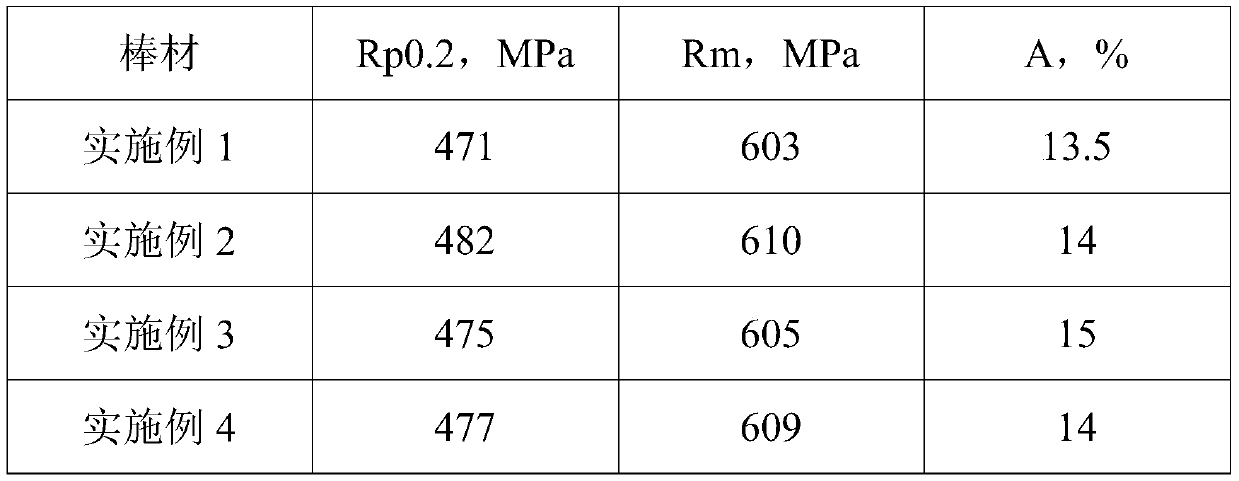Preparation method of short fiber reinforced high-temperature titanium alloy bar for 700-750 DEG C
A high-temperature titanium alloy and short fiber reinforced technology, which is applied in the field of titanium alloy, can solve the problems of poor plasticity, low structural strength, and unsatisfactory fatigue performance, and achieve small grain size, weakened texture strength, and uniform microstructure. Effect
- Summary
- Abstract
- Description
- Claims
- Application Information
AI Technical Summary
Problems solved by technology
Method used
Image
Examples
Embodiment 1
[0027] 1) Ingot melting: Sponge Ti, sponge Zr, pure Al, Ti-Sn master alloy, Al-Mo master alloy, Al-Si master alloy, Al-Nb master alloy, Ti-Ta master alloy, TiB 2 Powder and C powder are mixed evenly and then pressed into electrodes. After the electrodes are welded, alloy ingots are obtained by vacuum self-consumption melting for 2 to 3 times. The ingot size is Φ540mm; Sn 2.3%, Zr 3.4%, Mo 0.7%, Si 0.25%, Nb 0.4%, Ta 0.4%, Fe 0.02%, C 0.06%, B 0.3%, O 0.13%, N 0.003%, H 0.003%, The balance is Ti and unavoidable impurities. The β transformation temperature of the ingot is 1045-1050°C.
[0028] 2) Use a resistance furnace to heat the ingot obtained in step 1) to 1200°C for 6 hours, then repeatedly upsetting and elongating with a hydraulic press for 2 fires, the forging ratio of each fire is not less than 2, and the final forging temperature is not lower than 920 ℃;
[0029] 3) Using a resistance furnace, heat the forging blank obtained in step 2) to 1150°C and keep it warm for...
Embodiment 2
[0034] 1) Ingot smelting: the preparation method of the ingot is the same as in Example 1, the difference is that the diameter of the ingot is Φ620mm, and the alloy composition of the ingot is Al 5.2%, Sn 3.2%, Zr4.1%, Mo 0.68% by mass percentage %, Si 0.3%, Nb 0.4%, Ta 0.45%, Fe 0.018%, C 0.06%, B 0.3%, O 0.12%, N 0.003%, H 0.003%, and the balance is Ti and unavoidable impurities.
[0035] 2) Use a resistance furnace to heat the ingot obtained in step 1) to 1220°C for 6 hours, then repeatedly upsetting and elongating with a hydraulic press for 2 fires, the forging ratio of each fire is not less than 2, and the final forging temperature is not lower than 920 ℃;
[0036] 3) Use a resistance furnace to heat the forging blank obtained in step 2) to 1160°C and keep it warm for 6 hours, then repeatedly upsetting and elongating with a hydraulic press for 4 fires, the forging ratio of each fire is not less than 2.4, and the total forging ratio is not less than 5.6, The final forging...
Embodiment 3
[0041] 1) Ingot smelting: The preparation method of the ingot is the same as that of Example 1, except that the diameter of the ingot is Φ460mm, and the alloy composition of the ingot is Al 5.8%, Sn 2.3%, Zr 2.4%, Mo 0.45% by mass percentage , Si 0.5%, Nb 0.2%, Ta 1.4%, Fe 0.02%, C 0.05%, B 0.65%, O 0.12%, N 0.003%, H 0.003%, and the balance is Ti and inevitable impurities.
[0042] 2) Use a resistance furnace to heat the ingot obtained in step 1) to 1200 ° C for 5 hours, and then repeatedly upsetting, drawing and forging with a hydraulic press for 2 fires, the forging ratio of each fire is not less than 2, and the final forging temperature is not lower than 920 °C;
[0043] 3) The forging billet obtained in step 2) is heated to 1150° C. and kept for 5 hours by using a resistance furnace, and then repeatedly upsetting and drawing with a hydraulic press for 3 times, the forging ratio of each fire is not less than 2.4, and the total forging ratio is not less than 5.6, The final...
PUM
| Property | Measurement | Unit |
|---|---|---|
| Tensile strength at room temperature | aaaaa | aaaaa |
| Tensile strength | aaaaa | aaaaa |
Abstract
Description
Claims
Application Information
 Login to View More
Login to View More - R&D
- Intellectual Property
- Life Sciences
- Materials
- Tech Scout
- Unparalleled Data Quality
- Higher Quality Content
- 60% Fewer Hallucinations
Browse by: Latest US Patents, China's latest patents, Technical Efficacy Thesaurus, Application Domain, Technology Topic, Popular Technical Reports.
© 2025 PatSnap. All rights reserved.Legal|Privacy policy|Modern Slavery Act Transparency Statement|Sitemap|About US| Contact US: help@patsnap.com


